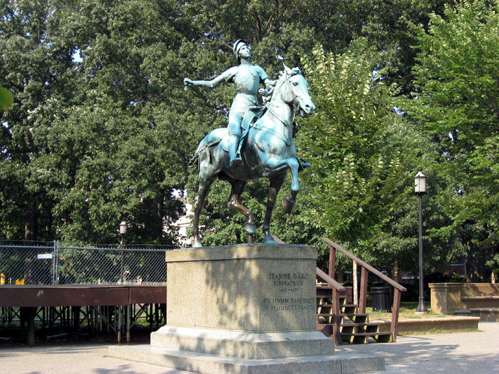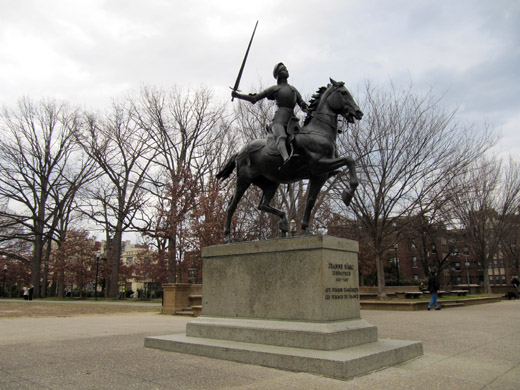“She would rise before us then, a vision to win us, not repel: a lithe young slender figure, instinct with ‘the unbought grace of youth,’ dear and bonny and lovable, the face beautiful, and transfigured with the light of that lustrous intellect and the fires of that unquenchable spirit.”
So wrote Mark Twain about Joan of Arc, the sole figure who could make him mute his famous disdain for medievalism. “[S]he is easily and by far,” he swooned, “the most extraordinary person the human race has ever produced.” (Twain considered Personal Recollections of Joan of Arc his favorite of his own books; his heroine’s penchant for mottos—”Work! Stick to it!”—prompted Shaw to brand her “an American school teacher in armor.”)
It’s hard to overstate what a big deal Joan of Arc was in America at the dawn of the 20th century—but like most spirited forms of medievalism, Joanolatry first rose overseas. In 1870, when the French lost Alsace-Lorraine to the Prussians, humiliated nationalists—when Europeans rouse medieval heroes from their graves, nationalism is usually the reason—made a symbol of the Maid of Orleans. American writers as early as John Daly Burk in 1798 cast Joan as an emblem of patriotism and pre-modern innocence, but by the late 19th century, European-influenced children’s books and chivalric romances about female heroes fired up men and women alike, as T.J. Jackson Lears points out:
The life of the chivalric warrior, male or female, ranged far outside the realm of reading circles and parlor chitchat. “Oh, to be a wild Kossack!” Emily Greene Balch wrote in her commonplace book after reading Taras Bulba. “Fight hard and drink hard and ride hard . . . Our clothes grow strait. Oh, for a horse between the knees, my blood boils, I want to fight, strain, wrestle, strike . . . To be brave and have it all known, to surpass and be proud, oh the splendor of it.”
Lears further argues that the American Cult of Joan was about more than escapism. For late 19th-century Americans, saints also “embodied instinctive communion with nature, simple faith unhampered by learning, and sexual purity. Personifying shibboleths of romantic liberal Protestantism, they entered the pantheon of the genteel tradition.”
World War I only gouged Joan further into American culture: She was immortalized on the Hudson in 1915, beloved by readers of Lucy Foster Madison’s 1918 novel (with its gorgeous Frank Schoonover illustrations), and brought to the screen by Cecil B. DeMille. Decades later, Joan was still sufficiently famous that OMD could write not one but two songs about her, while the Smiths could mention her and know that the image would stick.
According to the Book Haven, yesterday was the 600th birthday of Joan of Arc. Fortuitously, I learned this morning via D.C. neighbor and blogger George that the Joan of Arc statue in Meridian Hill Park, dedicated by President Harding on the saint’s birthday in 1922…

…but (as this 2007 photo shows) disarmed for decades…

…got her sword back just last month! (And got a full body scrub too.)
Congrats to locals, who reportedly lobbied the Park Service for two years to make this happen, and happy 600th to Miss of Arc, who was, as one of history’s greatest thinkers put it, “a most bodacious soldier and general.“

Jeff,
I think that statue of Jeanne d’Arc was copied from the one outside Reims Cathedrale. I’ll send you a copy of a picture we took this summer and let you judge for yourself.
Linda
LikeLike
Yep! They’re essentially the same statue; they were created at the same time by Paul Dubois. There’s at least one other sculpture by Dubois in America: an allegorical figure in a Baltimore park.
LikeLike
What happened to the sword? Is there a story? Pranksters? Is the one in her hand a new one?
LikeLike